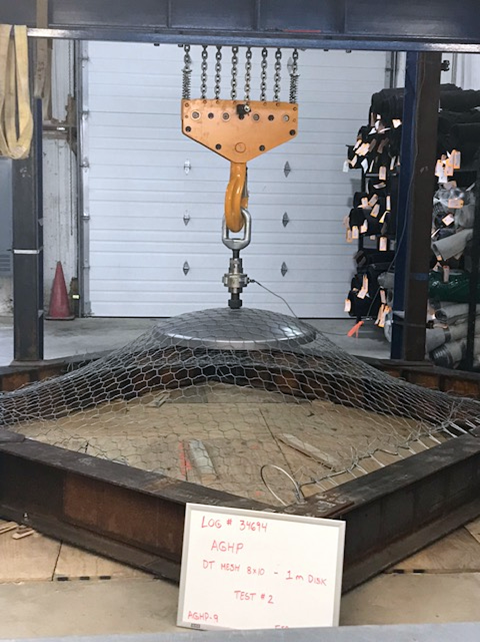News
Developing Testing Standards for our Industry
There are few standard specifications applicable to geohazard mitigation structures in North America. For those projects that do contain specifications, it is often seen that non-applicable ASTM or Federal specifications are cited. As an example, ASTM A975, a standard for double-twist gabions and revet mattresses, is often used when specifying mesh for rock slopes. The AGHP’s Standard Specification Committee is working to develop more appropriate standards that could be used by the industry that will help guide safe and efficient use of materials in the design and construction of solutions.
The current focus of the committee is to develop standard specifications for material characteristics of draped mesh systems, which are applied to unstable slopes to help control rockfall. This task is being undertaken in cooperation with the ASTM D18.25.06 Geohazard Protection Systems Committee. The long term goal is to have the standards published by the ASTM.
The committee identified several standards that are essential for the industry. Presently four standards are under development. Each standard outlines how samples are to be prepared, tested and documented.
- Test Method for Determining Mass per Unit Area of Geohazard Nettings – In the case of geohazard netting, the unit weight is the weight per unit area of the material, usually expressed in kg/m2 or lbs/ft2. This material property allows the engineer to specify the required weight of the drapery to help resist the movement of rock and debris.
- Test Method for Measuring the Opening Size of Geohazard Nettings – The mesh opening is a measurement of the maximum diameter of a circle that can pass through the mesh. It is an important characteristic of the material to define during design so that the appropriate debris is caught by the structure.
- Test Method for Tensile Strength of Geohazard Netting – Tensile strength refers to the ultimate load a mesh can sustain before failure when put under tension in plane with the material. It is tested both in a parallel and perpendicular orientation to the weave of the mesh. It is the strength of the mesh as a system and not of an individual strand or wire.
- Test Method for PuctureStrength of Geohazard Netting – Puncture strength refers to the ultimate load a mesh can sustain before failure when a force is applied to the material perpendicular to its plane. It is tested by pulling or pushing a plate through the mesh.
Both the unit weight and mesh opening standards have been completed and are expected to available in the near future. The tensile strength standard is near completion.
With regards to the puncture strength test, the AGHP has retained the services of TRI Environmental, Inc. to help investigate the behavior of different punch sizes. This aspect of testing is important since there is a large variety of products on the market that have differing mesh openings. Since the influence of the size and shape of the punch device is not well known, a series of tests is being performed whereby different diameter plates are used on the same mesh product. Once this is better understood, a test method will be written with the hope that a single method can be used for testing all types of mesh to help compare and guide the application of products.
The photos below show testing being carried out using a large, 1-meter plate. The mesh sample is secured to the metal frame. As the plate is pulled up through the mesh, the forces and elongation are measured until the point of failure.


